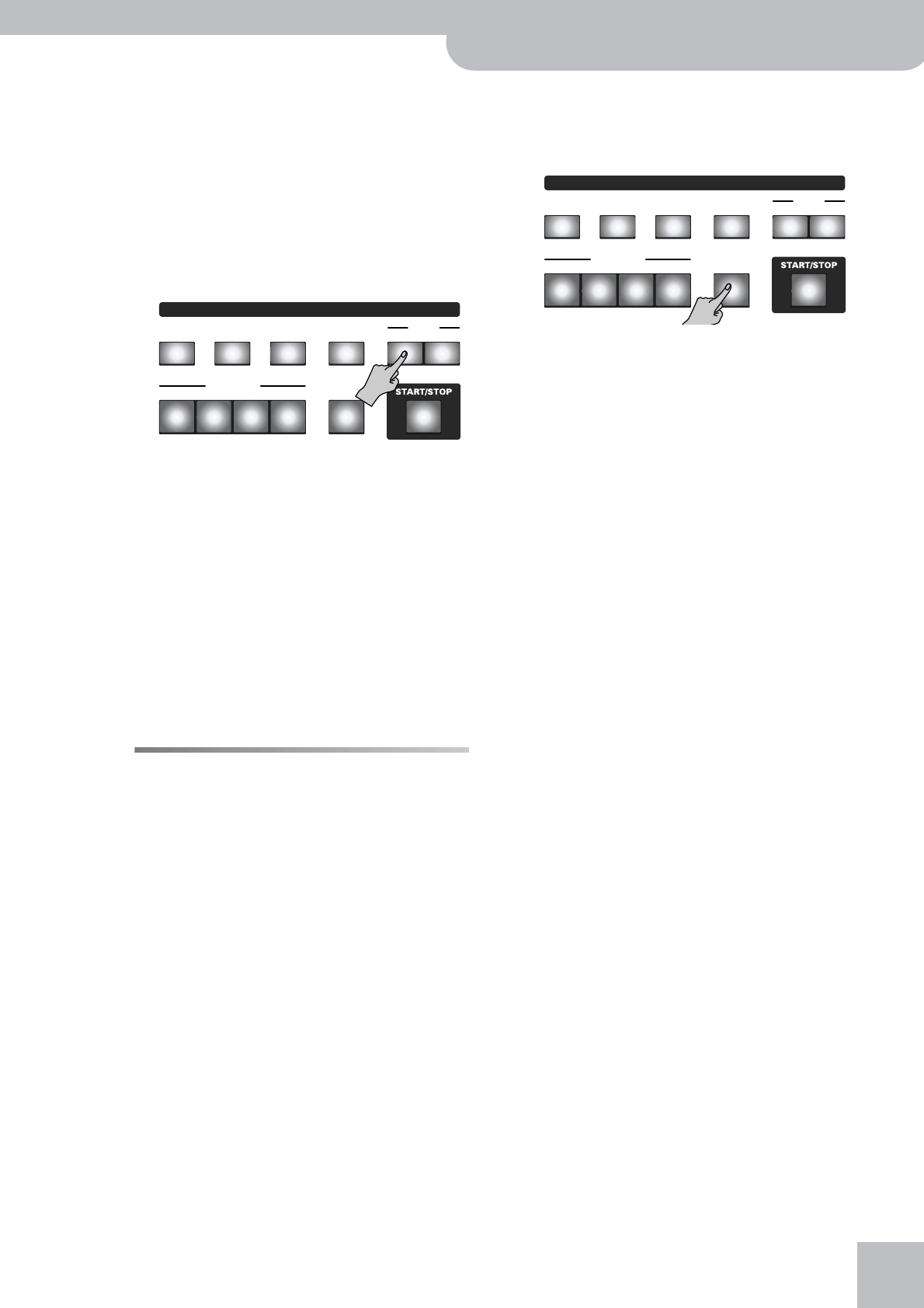
Selecting other Style divisions
G-70 Music Workstation
r
75
There is no need to restart Style playback manually if
you also activate SYNC [START] (see above).
Note: You can also use a Fade-Out. See page 138 for details.
About Sync Start & Stop
If you’ve never used an arranger keyboard before, the
status of the SYNC [START] button is the single most
important function to look out for after switching on
your instrument. If it is on, playing just one note on the
keyboard may cause the Arranger to start playing when
you don’t want it to.
Once you get to know the G-70 a little better, you will
appreciate this function, though.
SYNC START means that the Arranger starts as soon as
you play a note or chord in the chord recognition area
of the keyboard. (If the EASY SETTING [ARR] button
lights, this area is the left half of the keyboard. See
p. 80 for details.)
The G-70 also provides a SYNC STOP button. That
function causes the Arranger to stop playback as soon
as you release all keys in the chord recognition area.
This is great for songs where you need breaks (i.e. one
or several beats of silence).
Note: When you use ONE TOUCH to configure the G-70, SYNC
[START] is switched on.
Selecting other Style divisions
You can “professionalize” your performance with the
Arranger by selecting different accompaniment pat-
terns.
Here’s a quick overview of how the G-70’s Music Styles
are structured:
The numeric button you press flashes until the new
pattern is used (after which the button lights steadily).
You can use fill-ins (transitions) to go from one MAIN
VARIATION pattern to the next by switching on the
[AUTO¥FILL] button before pressing another (or the
same) MAIN VARIATION [1]~[4] button.
The fill-in that is played between the current and the
next VARIATION pattern depends on where you come
from. Each transition from one VARIATION pattern to
another (e.g. from [1] to [2]) is different from the others
(from [2] to [3], from [3] to [4], and from [4] to [1]).
There are three Fill-Ins for the upward direction (called
“Up” by the Style Composer) and three for downward
moves (“Dw”).
Note: You can also press [INTRO] in the middle of a performance.
In that case, the indicator flashes until the end of the current bar
and then lights on the next downbeat to indicate that the
Arranger is playing the introductory pattern.
Other ways of selecting Arranger patterns
You can also switch among Music Style patterns using
the keyboard’s aftertouch function, the ASSIGN SW
buttons or a footswitch. Here are the pattern selection
functions you can assign:
Note: Even aftertouch messages generated outside the chord
recognition area (see p. 80) trigger the selected switching func-
tion.
Bass Inversion
The Bass Inversion function allows you to change the
way the Arranger reads the chords you play.
If this function is off, A.BASS part (ABS) plays the root
of the chords that feed the Arranger, while the chords
of the ACCOMP 1~6 parts are voiced in such a way as
to avoid semitone intervals (for complex chords) that
wouldn’t sound very nice.
Bass Inversion gives you more artistic license because
you specify the notes played by the ABS part. Switch on
Bass Inversion for songs that rely on bass rather than
on chord patterns (for example C – C/B – C/Bb, etc.).
MAIN VARIATION [1] The simplest of the four basic accom-
paniment patterns. This pattern is ideal
for the first verse of a song.
MAIN VARIATION [2] A slightly more complex pattern. Con-
sider using it for the second and third
verses.
MAIN VARIATION [3] This pattern could be used for the first
chorus(es).
MAIN VARIATION [4] This is the most complex pattern that
could be used for the final choruses
and/or the bridge.
INTRO MAIN END/RIT START STOP
BASS
INVERSION
AUTO
FILL IN
VARIATION
123 4
SYNC
STYLE CONTROL
Aftertouch Fill Up, Fill Down, Fill Remain, Variation Up,
Variation Down, Intro, Ending (page 61)
ASSIGN SW Half Bar on Fill In (page 63)
D Beam Fill Up, Fill Down (page 65)
FC-7 PEDAL Start/Stop, Intro, Variat 1, Variat 2, Variat 3,
Variat 4, Ending (page 67)
Foot Switch Intro, Ending, Variat 1~4, Half Bar on Fill In
(page 69)
INTRO MAIN END/RIT START STOP
BASS
INVERSION
AUTO
FILL IN
VARIATION
123 4
SYNC
STYLE CONTROL


















